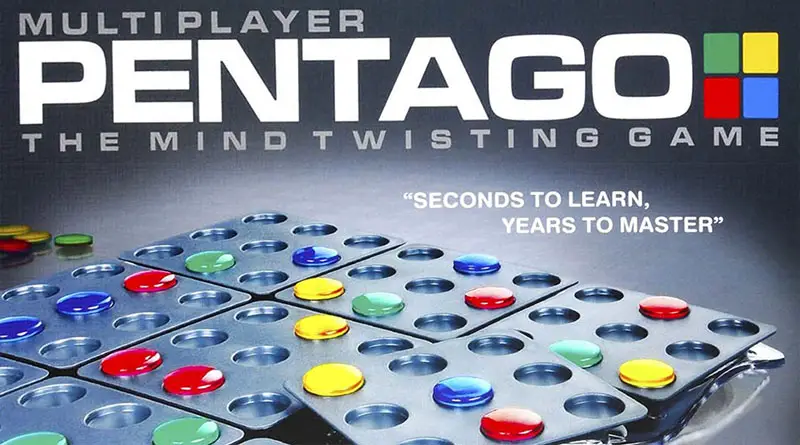
Pentago Multi-Player is a truly unique multi-dimensional game. Basic play is as simple as the original and award winning game 2 player Pentago.
Start on this page to learn how to play and read the rest of the guide for basic strategy tips.

Components
- 9 twistable 3x3 game blocks
- Yellow marbles
- Red marbles
- Green marbles
- Blue marbles
Setup
The game starts with an empty game board. You can play two, three or four individual players against each other. Or you can play two teams of two. Or you can play a team of two against one player. Decide game marker color of each player/team and who goes first.
Object of the Game
The object is to get five markers in a row before your opponent(s).

Game Play
Players or teams take turns at placing a game marker on a game block and twisting ANY game block 90 degrees (one notch), to complete a turn. A 180 degree (double "notch") twist is not allowed.
In the beginning of the game, there will be empty game blocks, allowing a player to ignore the twist part of the turn, as it doesn't affect the game to twist an empty game block.
Once there's a marker on all the game blocks, the twist is mandatory. Twisting is the key to create winning moves in Pentago.
Multi Player Options
If you play two, three or four players against each other, game play is very standard and straight forward; take turns playing and first to five markers in a row wins.
If you play teams, you can either have each team play the same color, so that it's blue vs. green, for example. Team members alternate turns for their respective teams.
You can also play the tournament team rule, where the team members are not allowed to tell each other what to do on their respective turn, but must work together by understanding each others game strategy to create winning positions and defend against attacks.
You can also play teams, where each player is using their own color, so it's red-blue vs. green-yellow, for example. Team red-blue must create either a red or blue row of five markers to win, same for team green-yellow. Try this team method with the tournament team rule.
Finally, you can also play one player vs. two that acts as a team, where the team either uses the same color, so it's blue vs. green or the team has different colors, so it would be blue vs. green-red, for example.
Team play with different colors create a slightly different game dynamic. The basic idea is that Pentago is multi-player and also multi-option. Have fun and experiment with different ways of playing and choose your favorite.
End of the Game
A winning row of five markers can occur vertically, horizontally or diagonally, anywhere on the board and span two, three or four game blocks.
Various ways of Winning
In Pentago Multi-Player, there are four ways to connect five markers in a row for a win. Each play can span two or three game blocks.
The Triple Power Play can span four game blocks. Each play has it's own strengths and characteristics. To play well, use your turn to build towards a winning combination and watch for your opponent(s) doing the same.

1 Monica's 5
This is one of two diagonal plays and it goes right down the diagonal middle of a game block. It 's a fairly obvious strategy and it's easy to defend against.
It 's called Monica's Five because one of the designers wife favored this technique. The designer considered this a weak strategy and mostly ignored it and ended up losing many a games to Monica. So while it is considered the easiest strategy to defend against, it can obviously be rather effective.
2 The Middle 5
This play is a horizontal or vertical row of five in the middle of two or three game blocks.
3 Triple Power Play
This is perhaps the most powerful play of the game in that it is deceptive and versatile and it doesn't require three in a row on any one game block in order to set it up. You can play this on three or four game blocks, which makes it's very deceptive while you build it. It 's tough to defend against, and there are many different ways to set it up.
4 The Straight Five
The Straight Five is one of the most powerful plays on the board in that it takes a lot to defend against it, once you get three in a row on one block. its versatility makes for a powerful play and if you can get three in a row on the middle block, this play can be devastating.
Strategy Open Four
Playing for an open four is a very powerful strategy in Pentago Multi-Player. You can set up the open four play to be incredibly hard to spot until it's too late. If you're playing against just one other opponent, getting the open four means a certain win.
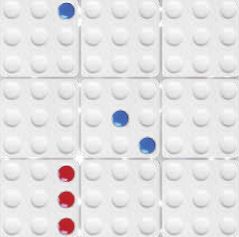 In this example, it looks like red has the edge, with three in a row on a block, which is a strong position But blue has cleverly arranged the markers for an open four play. |
 Blue places a marker and twists as The arrows show. |
 This is an open four, which means that nothing blocks the formation from either side. A single opponent cannot defend against this and keep blue from winning on the next turn. |
 Red places a marker where the arrow shows and twist the middle in an attempt to block the open four. |
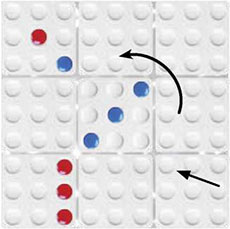 Blue will place a marker and twist the middle back as the arrows show. |
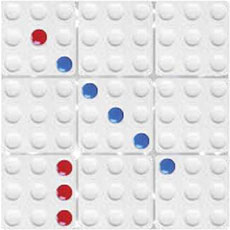 Blue wins before red could even get five markers on the board. |
In this example, Red has managed to a create an open four. Three players are playing against each other and the only way that Red will not win on its next turn, is if Green and Yellow both work together for a moment to stop the open four.
In this example, Red just went to create the open four and it's now Green's turn.
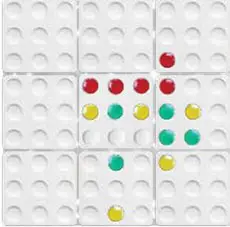 It's green's turn, who has to figure out how to defend against red's open four |
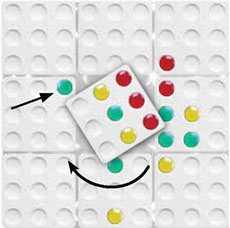 Green places a marker where the arrow shows and twists the middle. Green still needs to rely on yellow to also help defend against red's open four. |
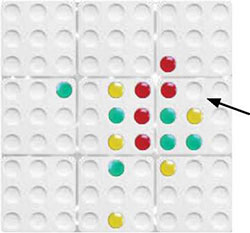 The threat of the red open four is. only partly removed. If it was red's turn now, red could just place a marker where the arrow indicates and twist the middle back to its original position to win |
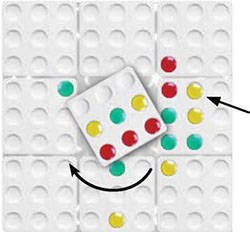 Yellow places a marker where the arrow shows and twists the middle another notch. |
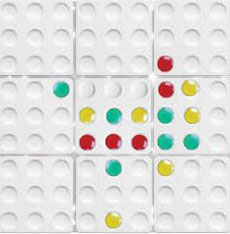 Red's open four threat has been eliminated for now. Red still has the strongest position, because of the three markers in a row on the center block. Both yellow and green have a poor position at this pont. |
Continue Reading



